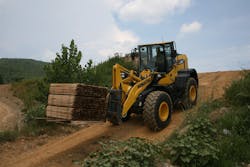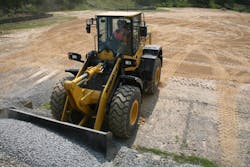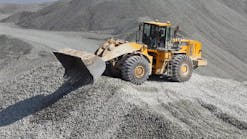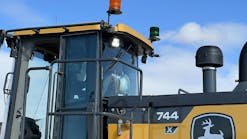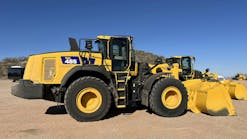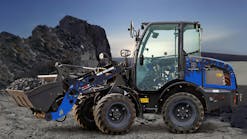Hydrostatic Transmissions Provide Smooth Operations
Hydrostatic transmissions, or HST, have been available in the construction marketplace for quite a while on crawler dozers with similar designs on excavators. But it’s only within the past decade that the number of dozers and wheel loaders with HST has exploded, and the reason is simple: hydrostatic transmissions make machine operation so much easier and smoother.
The biggest benefit of a hydrostatic transmission is the elimination of a mechanical transmission with fixed gear ratios. This gives operators infinite variable speed control or output, while keeping the engine speed constant.
How an HST works
With hydrostatic transmissions, the engine can operate at its most efficient power output, while the hydraulic pumps and motors constantly adjust to vehicle power and load requirements. The pump(s) drive motor(s), which are really piston pumps being driven as motors, which infinitely vary flow while maintaining constant engine horsepower and rpm. The process eliminates having to change engine rpm to change speed as required with a fixed-gear-ratio mechanical transmission.
Pumps and motors are typically controlled by EPC (Electronic Proportional Control), which varies power and speed as required by an HST controller. By using variable-displacement pump and motor technology, hydraulic flow and power can be constantly adjusted. When the system senses increased load (pressure), the pump or motor displacement is reduced to maintain constant hydraulic horsepower without lugging the engine. The pump/motor controller typically has the capability to be set to hold constant engine speed and vary flow, or to fix pump displacement and vary speed by changing engine rpm.
It’s all about the oil
Hydraulic fluid is the lifeblood of an HST machine. Much like the human circulatory system, the HST machine depends on hydraulic fluid to transmit power, lubricate, and cool its vital components. HST machines often use a flushing circuit, which takes excess oil back to the reservoir tank where it can be cooled, filtered, and re-used.
Smaller engines and greater fuel efficiency
Machines with HST typically use a smaller engine with less displacement than a machine with a conventional transmission. Freeing the engine from the high-low-high-rpm engine speed and load cycles, HSTs can use a smaller engine and maintain constant rpm and horsepower, which can extend engine life and load. More efficient, smaller engines can help reduce fuel consumption by up to 10 percent in power mode under demanding working conditions, and up to 20 percent in economy mode under lighter load conditions.
Typically, there are also fuel efficiencies among HST machines. By utilizing an electronic control module (HST controller) an HST machine is able to maintain a constant engine speed at the most efficient engine operating rpm.
Inside the motor of an HST
A typical HST variable displacement motor or pump has multiple pumping pistons and a swashplate that can be adjusted to change the piston stroke and output flow. A long piston stroke produces high flow volume/speed, while a short piston stroke creates low flow and high power. An HST motor can also incorporate brake discs that are usually spring applied and hydraulically released.
As the operator moves the HST speed control, it, in turn, commands a change in swashplate angle and flow. To maintain constant horsepower, the machine adjusts hydraulic output. As load (pressure) increases, hydraulic flow decreases, and as load decreases, pump flow increases to maintain constant horsepower.
HSTs drive design opportunities
Although it varies among equipment manufacturers, HSTs generally are found in machines in the small-to-mid-range sizes. The ability to remove the mechanical linkage between power and drives and use hoses instead, has also allowed OEMs to redesign where components go in the machines.
Reprinted with the permission of the Association of Equipment Management Professionals. Photos courtesy of Komatsu.
When OEMs use hydrostatic transmission design, it allows them to rethink a variety of elements. The ability to move things around means new designs can change multiple elements at once, instead of typical, evolutionary, model-to-model changes. Literally thousands of hours go into designing a power shift transmission, not only because of the fixed gears, but because the machine must be designed for a specific load and power requirement. With an HST machine, design time drops radically because only pump size and volume variables change.
Best applications for HST drive
Cycling applications are the best way to deploy an HST machine. For wheel loaders, that includes pallet handling, loading trucks, or maneuvering on rough terrain; for dozers, it is sloping (straight travel maintained on slopes), finish grading, spreading, and curbing.
What operators say they appreciate most when comparing an HST and a mechanical transmission is how much easier it is to run an HST machine. Today, many dozers allow operators to set forward and reverse speeds. If they want to fine-tune speed, they can bump it up or back with a push forward or backward of a lever, versus shifting up or down with a mechanical transmission. This feature means that every operator on the site can program a machine with their personal preferences, and the setting change is instantaneous—no time is lost on the job.
Hydrostatics at work
Depending on the material, the speed of the machine can be tuned far more precisely with an HST than with a torque converter transmission, because of the latter’s limited and finite gears. HSTs also have the benefit of dynamic braking. By easing off the throttle, the hydraulic pressure within the system will bring the machine to a stop. This is particularly important when working on a slope because the hydrostatic system will keep the machine from rolling backward.
When operating an HST dozer, independent hydraulic pumps and motors power the left and right tracks. Changing the speed and/or direction of the motors allows a dozer operator to power steer and counter-rotate.
The advent of machine control has boosted the adoption of HST in construction machines. The infinite speed control provides tremendous benefits when coupled with the grade accuracy of GPS machine control because an operator can work far more quickly when there’s no need to choose between higher and lower gears.
For example, with machine control, as a dozer makes its initial cut and loads the blade, the machine senses the load. The electronic control module and control logic understand the pressures and vehicle position, and how fast the tracks are going. The machine can load the blade to maximum because it senses track slip and can adjust track speed to use the machine’s full capabilities. This also helps minimize track wear.
Additionally, HSTs combined with machine grade control can change the fleets contractors need. As dozers become more multifunctional, they reduce—and in some cases eliminate—the need for motor graders.
One other benefit of the one-two punch of HST and machine control: It can help address the dearth of skilled operators in the construction industry. With HST and machine control, a relatively inexperienced operator is more productive sooner and can increase their skill level faster.
Maintenance and hydrostatics
There are no stark differences between the maintenance needs of an HST and standard transmission machine. Scheduled maintenance for an HST machine includes changing hydraulic filters, cleaning hydraulic filter screens, changing fluids, and taking oil samples at specified intervals. Because HST transmissions don’t require clutch discs, transmission wear diminishes, as do rebuild and maintenance requirements.
Another advantage to HST machines is extended component wear, due to the constant engine speed. Because of variable displacement hydraulic flow, machine starts and stops are smoother, reducing the stress on every component including the undercarriage, final drive sprocket and track chain.
--Isaac Rollor is training instructor/developer for Komatsu America.
